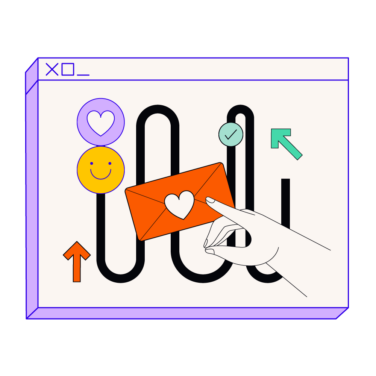Do slogans still matter? It’s a fair question for SaaS leaders in an increasingly digital world. Slogan usage appears to be declining as marketing budgets shift to digital formats that don’t always lend themselves to slogans. Kantar, an ad agency, saw the number of ads featuring slogans drop to 50% in 2022, down from 74% in 2014.
But here’s the thing: slogans are effective, and not only for traditional ad mediums like television and print. Digital ads using slogans also see a 14-point increase in brand recognition. And 47% of people say a slogan is important when deciding whether to make a purchase. For SaaS brands, an effective slogan can help differentiate from competitors and stick in the minds of potential users.
But does every brand need a slogan? And if so, how do you avoid common mistakes and craft one that resonates? This guide will discuss what makes a good slogan, review examples of effective SaaS slogans, and outline a step-by-step process for writing a powerful slogan that boosts your brand.
What’s The Role Of A Brand Slogan?
A brand slogan is a short, memorable phrase that captures the essence of your brand. Together with your logo, your company’s slogan is a key part of your brand and typically occupies valuable real estate in ad campaigns and marketing copy.
Slogans serve several functions:
- Sets customer expectations: A great slogan gives customers an idea of the experience your product will provide. This shapes their interaction with your SaaS product.
- Reinforces brand identity: Repetition of a slogan in marketing materials and campaigns cements your brand image in potential customers' minds.
- Creates an emotional connection: A good slogan forges an emotional bond with your audience, tapping into their aspirations, pain points, and desires.
- Differentiation: A distinctive slogan differentiates your brand from competitors and makes it clear who your target market is.
The terms “slogan” and “tagline” are often used interchangeably, but there’s a difference: taglines speak to the brand as a whole, while slogans are suited to the needs of individual marketing campaigns. Brands can have multiple slogans, but typically only one tagline. However—confusingly enough—the term “brand slogan” tends to be used with the same meaning as tagline.
Do All SaaS Companies Need Slogans?
General Electric spent more than $100 million dollars in 2003 to roll out its new slogan, “Imagination at Work,” along with an accompanying marketing campaign. Faced with this kind of example from big business, some SaaS brands—especially bootstrapped companies—might be tempted to ignore extensive branding exercises to focus instead on product development and growth.
But most SaaS brand slogans don’t require anything like this kind of investment. And that’s good news, because the need for slogans is unavoidable. Regardless of whether you use slogans in your marketing copy, you’ll find yourself in all kinds of situations where you need to represent your brand in just a few words:
- Conferences
- Print and digital ads
- App store descriptions
- Public relations interviews
Taking the time to design a slogan means that when the need arises, you’ll know how to confidently represent your brand in a way that’s true to your vision, values, and audience.
What Makes A Good SaaS Slogan?
Some slogans stand the test of time: “You’re in Good Hands with Allstate” dates back to 1950 and is still in use today by Allstate, an insurance company. Others, like Pepsi’s “Any Weather Is Pepsi Weather,” have long since disappeared.
A 2014 study found that likable slogans have a few things in common: the clarity of the message, the communication of benefits, and the creativity of the slogan’s wording. And—in good news for startups—a slogan’s likability isn’t related to how much money you spend promoting it.
Interestingly, the study found that brevity doesn’t affect how likable slogans are, despite the standard industry practice to keep slogans to just a few words (like Apple’s “Think different”).
The best slogans share these common traits:
- Simple and concise: Easily understood and remembered. Creates a memorable “hook” to grab attention.
- Communicates brand promise: Distills what makes your brand unique.
- Evokes emotion: Connects with target users’ aspirations and frustrations.
- Unique: Differentiates your brand from competitors.
- Flexible: Leaves room for your brand to evolve over time.
- Empowers employees: Gives your team a unified purpose. (Plus, it provides employees with an easy answer when people ask “So tell me, what does your company do?”)
Keep your slogan simple, and make its meaning crystal clear.
The best way for your slogan to fail? Making it too generic. Customers want authenticity, not vague platitudes that could come from any brand.
The Impact Of Slogans On Customer Experience
From the moment customers encounter your brand, the customer experience begins. Here’s how your slogan ties in directly into your CX:
- Shapes anticipated experience: Your slogan gives users a preview of your product experience. This frames their first impressions.
- Encourages actions: Vague slogans give a general feeling about your brand. Highly differentiated and benefits-focused slogans can prompt behaviors like increased signups.
- Establishing metrics: If your slogan mentions product benefits, it may directly affect CX metrics. For example, a slogan that proclaims speed or ease-of-use can affect time-to-value.
- Affinity: Slogans can create an emotional response in customers, planting a seed that grows into future brand advocacy.
- Team alignment: An effective slogan rallies employees around a shared purpose, which in turn impacts how employees interact with customers.
Given the significant brand experience implications that slogans have, it’s crucial to validate them internally to make sure the slogan sets expectations that can be reasonably fulfilled.
A Step-by-Step Guide To Writing Your SaaS Slogan
Before writing your own business’s slogan, consider reading through other SaaS companies’ branding journeys. Typeform, for example, took nearly a year to develop theirs, though that happened in the context of a full rebrand. Like any branding exercise, developing a slogan can be full of twists and turns, requiring creativity, time, and feedback from different stakeholders.
Although your process may go much quicker, be prepared to take it slow if necessary.
Here’s a 5-step plan for writing your SaaS slogan:
Step 1: Define Your Brand Identity
Make sure you go into the slogan-writing process with a strong idea of what your brand values, purpose, and vision are, as well as a clear understanding of your target audience. If you don’t have those established yet, tackle them first.
Don’t worry about getting your brand identity perfectly articulated. Just get the general ideas down so you can begin transforming them into memorable phrases.
Step 2: Simplify
Look for common themes within your brand identity. Then, start simplifying and distilling the core of what your brand represents.
From the outset, you’ll want to optimize for likability and emotional connection. As you identify the core concepts you want to communicate, make them as endearing as possible and inject layers of emotion onto the benefits you convey. For example, GitHub’s “Build Software Better, Together” gives users a sense of community while highlighting the platform’s benefits.
As you brainstorm options, be careful not to go too short with your slogan. Hubspot’s “Grow Better” is a good example of a strong two-word slogan, but remember that short slogans—while trendy—don’t offer an increase in likability.
Step 3: Review Competitors
Look at your competitors’ slogans: are there approaches that are so commonly used that they feel tired or predictable? If any of the slogans you’ve developed so far feel repetitive or unoriginal in the context of your market, cross them off. You should be left with a slimmed-down list of slogans that help to differentiate your brand.
Step 4: Validate Internally and Externally
Take the options that remain and discuss them with internal stakeholders. Make sure the slogans align not only with their vision of the brand, but with their capacity to deliver on the expectations created by the slogan.
Next, take your shortlist to trusted customers for feedback. See if your slogans resonate. Do customers agree that they capture your brand essence, or do they find them confusing? You might be surprised at what does—and doesn’t—resonate with customers.
Step 5: Finalize and Integrate
It’s time! Get ready to roll out your slogan. Once you’ve selected the slogan that best represents your brand, start the process of integration with your websites, marketing materials, and employee onboarding materials. Use your slogan as frequently as you can to reinforce your brand.
5 Examples of Effective SaaS Slogans
It can feel like nearly anything is slogan-worthy in the informal world of SaaS: Zenefits features a made-up word its company slogan "Less paperwork, more peoplework,” while X (formerly Twitter) features the enthusiastically vague slogan “Blaze your glory!”.
But the most successful SaaS slogans have plenty in common—they’re easy to understand, clear, succinct, and they cleverly distill what makes the brand unique.
Here are five successful SaaS slogans:
1. Deel
Slogan: “Bring The World to Work”
Impact: Deel is a global HR solutions platform, so its slogan feels as straightforward and benefits-focused as it gets: it’s all about helping companies hire people internationally. But it’s also full of purpose, hinting at Deel’s greater mission to eliminate hiring borders and help people around the world access new opportunities.
2. ClickUp
Slogan: “One App to Replace Them All.”
Impact: ClickUp is a productivity platform with ambitions to eliminate the complexity of jumping between different apps. This slogan alludes to a common customer pain point—a feeling of overwhelm from juggling too many apps—and promises a simpler future with more time saved.
3. Zapier
Slogan: “The Easiest Way to Automate Your Work”
Impact: Zapier’s slogan is succinct and benefits-driven, highlighting the reason to use the platform as well as the idea that automation—something that feels complex—can be easy.
4. Drip
Slogan: “Empowering the Ecommerce Rebellion”
Impact: Drip, an email marketing software platform, uses its slogan to position itself in a wider battle between independent brands and large marketplaces like Amazon and Walmart. The brand makes the calculated decision that its audience, and the emotion they need to feel, are a higher priority than a functional message about marketing automation.
5. DocuSign
Slogan: “The Fastest Way to Get a Signature”
Impact: DocuSign’s slogan is genius in its simplicity; anyone reading it could tell you exactly what the platform does. It drops cleverness for clear communication and focuses on the key benefit of speed and simplicity—crucial for anyone who’s gone through more arduous methods of getting a signature.
In The Digital Era, Slogans Still Matter
Unlike the big businesses of the past, your SaaS brand doesn’t necessarily need a brand slogan that lasts for decades. Tech companies need to be more nimble than ever before. Adapting to changing circumstances may well mean tweaking your slogan with some regularity.
But despite the changes of the digital era, it’s as important as ever to be able to communicate the essence of your brand through a slogan. By distilling your brand down to a simple, consistent phrase, you’ll set the right expectations with customers, build affinity, and lay the foundations for a successful customer experience.
Ready to explore more insights about branding and CX? Read up on the difference between a brand promise and a slogan. Or, subscribe to our newsletter to get the latest CX leadership tips, marketing strategies, insights, and industry trends.


